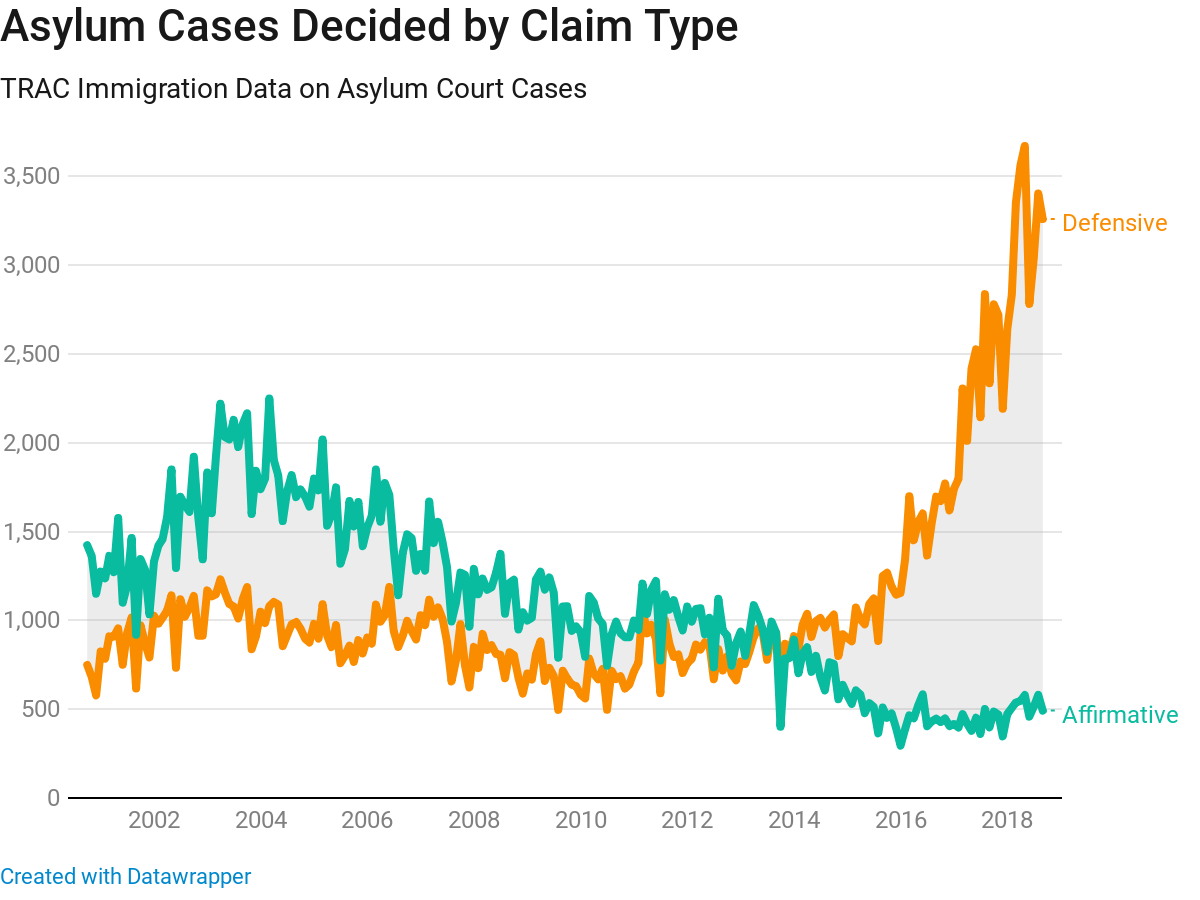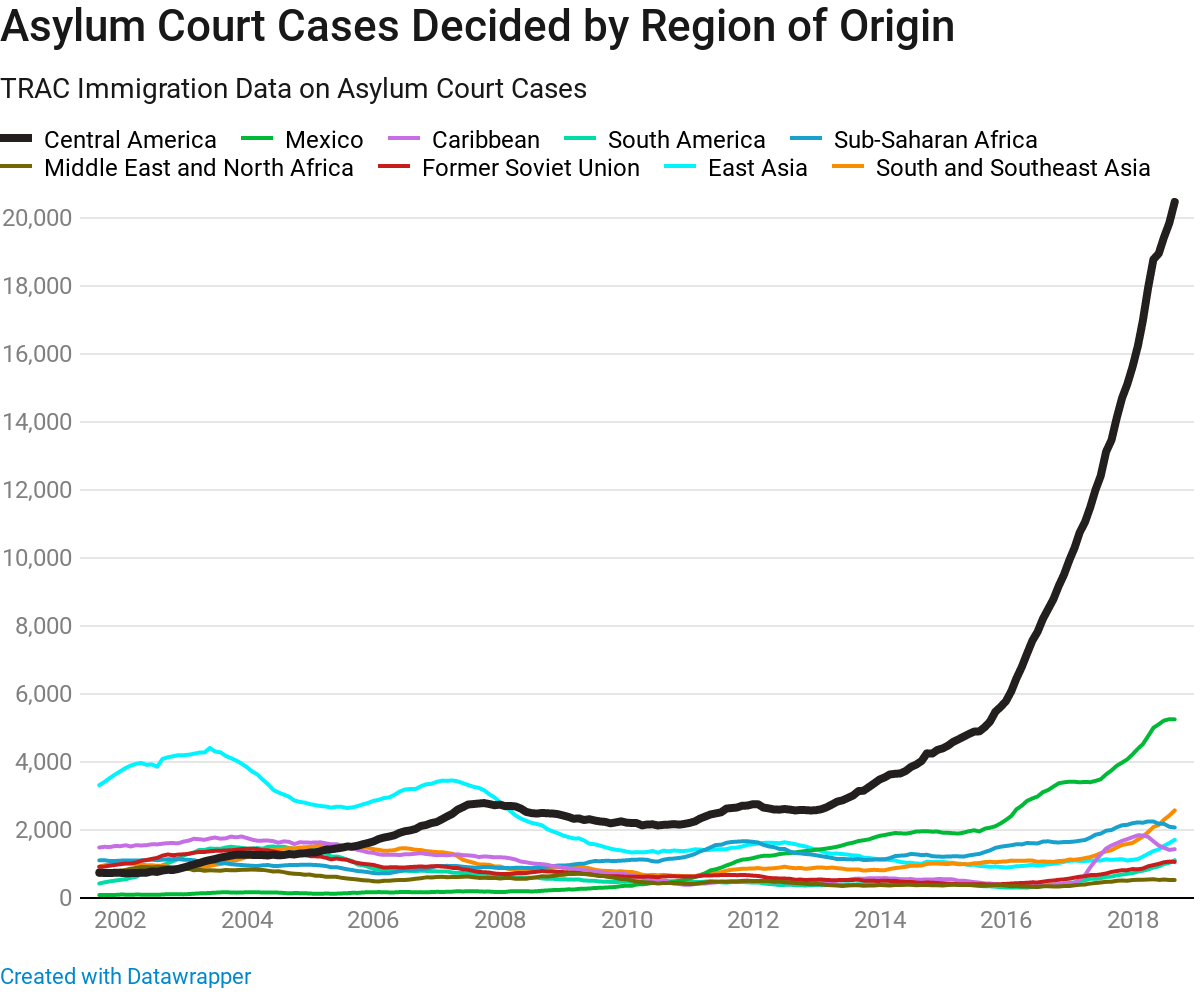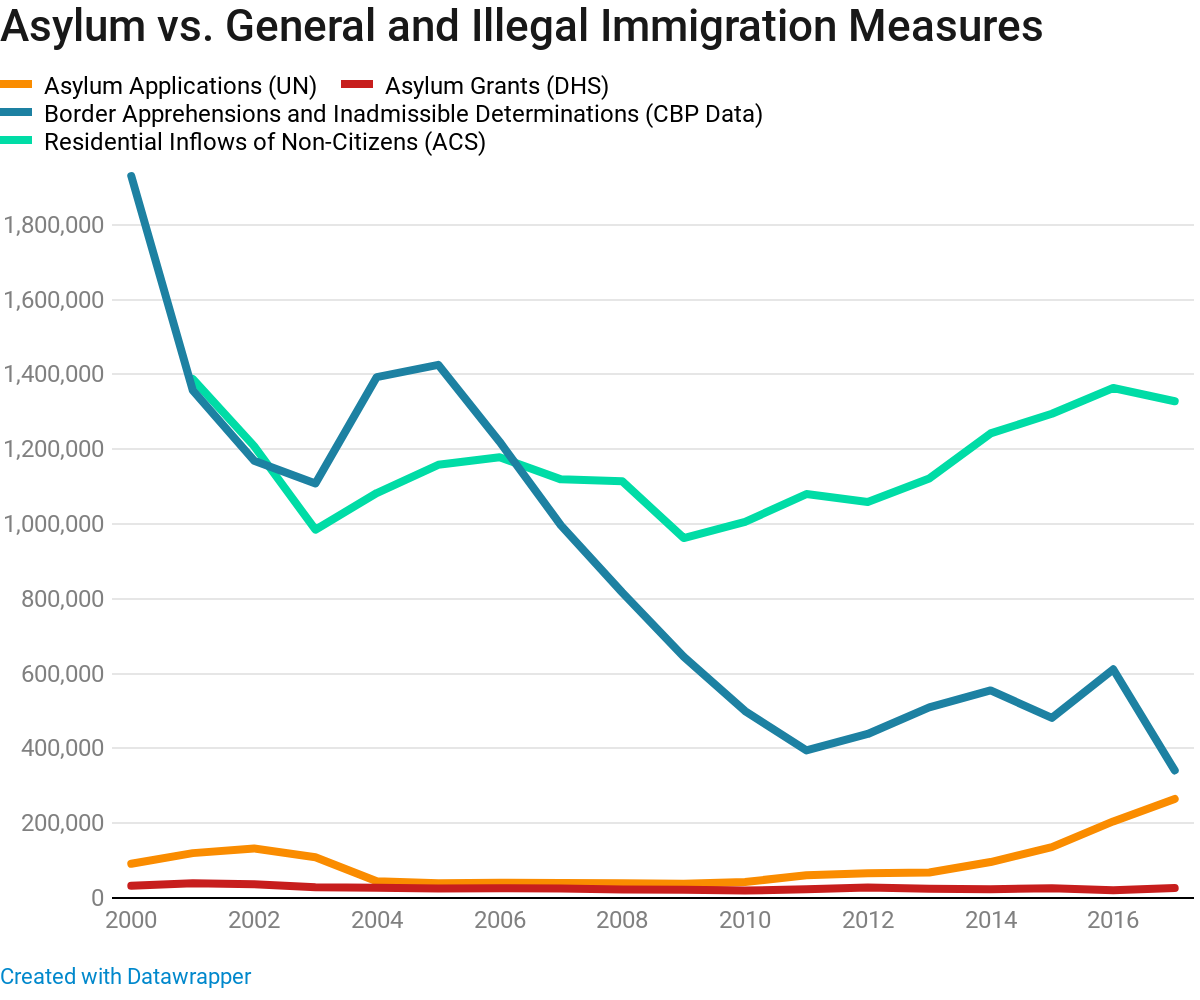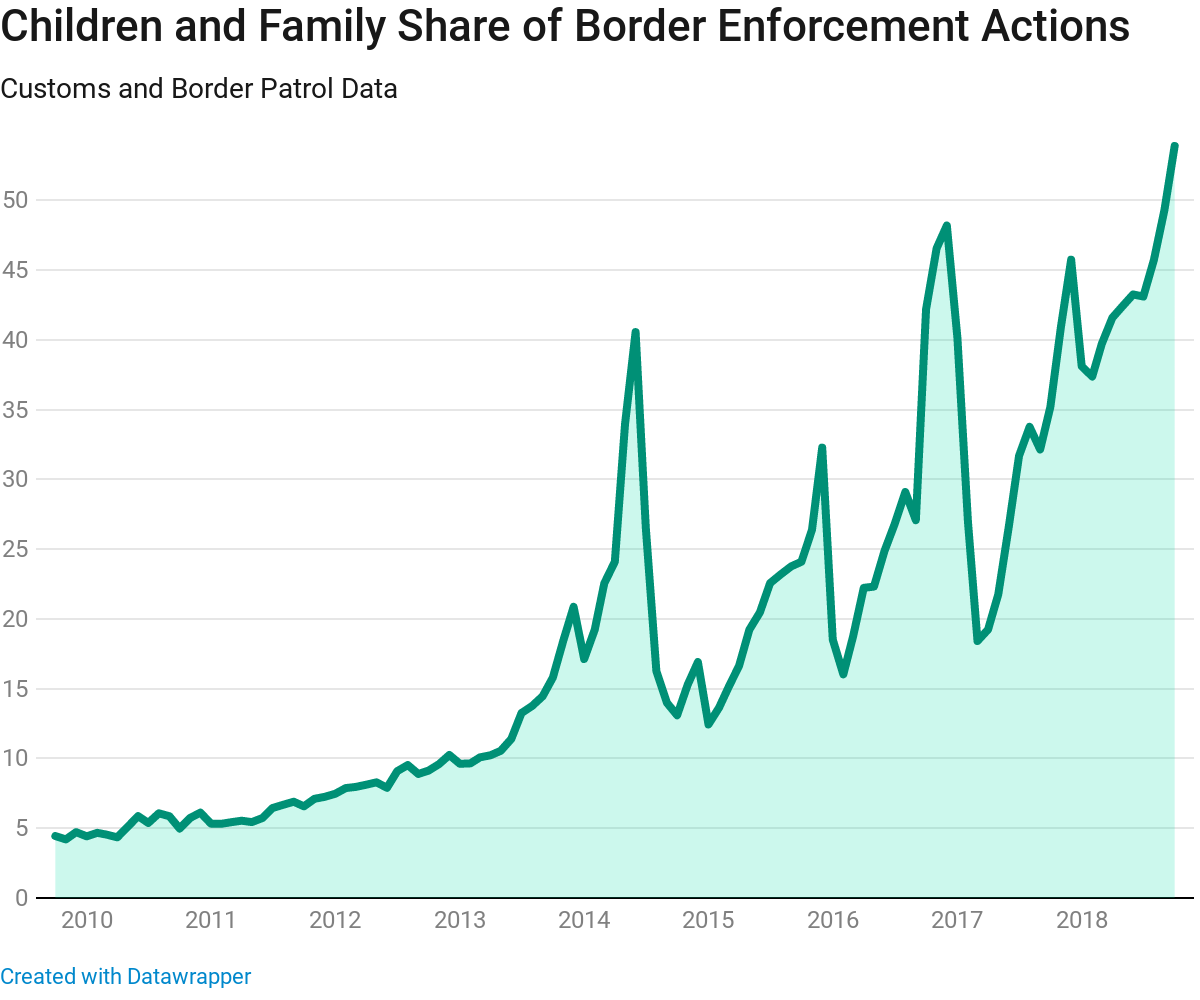The Real Border Crisis Is About Foreigners Gaming America’s Asylum Laws We need a wall, but we also need the resources to defend the wall: judges to convict violators, court officers to manage detention centers, etc. By Lyman Stone
http://thefederalist.com/2018/12/11/real-border-crisis-foreigners-gaming-americas-asylum-laws/
Late last month, frustrated migrants rioted just beyond the U.S. border crossing in Tijuana, and were dispersed with tear gas. The images were genuinely fear-inducing — crowds of immigrants surging against the wall, scaling it, many breaking through, some retreating. It was exactly the kind of chaos that conservatives have been predicting for years. Perhaps in response, the military presence on the U.S. border has been extended through January.
But what’s really going on? Is there really a crisis at the border? Is illegal immigration totally out of control? A look at the data suggests there is indeed an unprecedented surge in one specific kind of migrant, which may be cause for some concern, but that, overall, the situation at the border remains well in hand. Conservatives and progressives both would do well to calm down, address the limited, real problems, and stop fearmongering about a widespread crisis that does not actually exist.
A Real Surge in Asylum Claims
Many of the largely Central American migrants arriving at the U.S. border nowadays have a more sophisticated strategy than Mexican migrants from decades past. Today’s immigrants make heavier use of legal, or potentially legal, strategies for entry. This is partly thanks to improved physical security of the border, but has other causes as well.
A key channel for obtaining legal stay in the United States is to apply for asylum. The right of asylum is enshrined in U.S. law, and is recognized by virtually every country in the world. Basically, the idea is that if a person faces “credible fear” that he or she will be subjected to violence or other serious discrimination based on various protected categories like race, religion, or political affiliation, countries aren’t supposed to deport that person.
Deportation is not supposed to be a death sentence. As such, pretty much all countries offer various forms of asylum to people who might not otherwise have a legal right to be in a country.
There are basically two kinds of asylum: “affirmative” and “defensive.” Affirmative asylum-seekers have not yet been subjected to deportation proceedings, while defensive asylum-seekers have. Practically speaking, the actual distinction tends to be that affirmative asylum-seekers already have a legal reason to be in the United States and are trying to avoid deportation, while defensive asylum-seekers are more likely facing a losing court battle and grasping for strategies to remain in the United States.
We don’t know exactly how many affirmative or defensive asylum cases are filed each year. But total asylum applications through the end of 2017 are known, and have been surging. There were about 40,000 or 50,000 applications per year during the 2000s, but in 2017 asylum applications reached about 260,000.

Much of this is driven by Central American asylum-seekers. 2017 saw nearly 115,000 petitions for asylum from Salvadoreans, Guatemalans, and Hondurans, as well as 27,000 from Mexicans. In 2010, it was just 6,000 for the three Central American countries, and 4,000 from Mexico. But other countries have risen as well: Venezuela’s applications are up by 30,000; China and India are each up by about 5,000; Ecuador and Haiti are up by about 3,000.
For perspective, total immigration into the United States, depending on who you count as an immigrant, is somewhere between 1 and 3 million people. Granting 260,000 asylum petitions, then, would be a very big expansion of immigrant inflows.
Of course, not all asylum petitions are granted. In fact, most aren’t. Using data from immigration courts, we can see the share of decisions in asylum cases that end in the person’s claims being rejected outright. Cases not rejected are either granted asylum, or some other relief is provided to them besides asylum, so it’s easiest to just look at the straightforward rejection rates.

Affirmative applications are usually granted. While the rejection rate for affirmative asylum seekers (that is, people who are legally in the United States and proactively seeking asylum when they are not facing deportation proceedings) has been rising slightly under President Trump. More than 70 percent of affirmative asylum cases are decided in favor of the asylum-seeker. Usually, affirmative asylum-seekers have legitimate claims to facing danger in their home country.
Defensive applications are another story. Rejection rates have been stable around 60 or 70 percent under presidents Bush, Obama, and Trump. Defensive asylum cases are usually not ultimately credible. Now, this doesn’t mean you can reject them out of hand — 20 or 30 percent of these cases do involve somebody with a legitimate humanitarian reason to be in the United States. Still, this class of asylum-seekers are less likely to be legitimate.
Pooling all asylum cases from 2007 until September 2018 and controlling for country of origin, the average difference in rejection rate between affirmative and defensive asylum claims is about 10 to 20 percent. But even controlling for affirmative or defensive claim status, applicants from some countries are vastly more likely to be rejected, particularly those from Mexico, Central America, and the Caribbean.
In other words, if you know that a person is making a defensive or affirmative asylum claim, and you know what country they’re from, you can often predict how their case is going to end. For some nationalities like Mexicans and Haitians, about 90 percent of cases will be rejected. For Central Americans, it’s about 85 percent.
In other words, asylum claims are growing, but many end up being rejected, and rather predictably so. So that leaves the question: What types of claims are driving the growth in asylum-seeking? Defensive ones.

In other words, there has been a massive surge in court cases involving applications for defensive asylum, but no increase in cases for affirmative asylum. Virtually the whole increase is among applicants facing much lower odds of actually being eligible for asylum.
What countries are these defensive asylum applicants coming from? For the graph below, I show the rolling total of defensive asylum cases concluded in the previous 12 months. This is just a way to smooth the graph out for easier reading since there are more lines.

There has been an uptick in defensive asylum claims from virtually all regions in the last year or two, however, the modest increases in, for example, Chinese or Ecuadorians applying for asylum has been dwarfed by the number of Salvadoreans, Hondurans, and Guatemalans making defensive asylum claims. Mexico has also seen a sharp rise. These claims are rapidly rising in number.
As we’ve already established, these claims are the least likely to be valid claims of asylum. Crucially, this only measures cases concluded: UN data show that by the start of 2018, pending asylum cases had risen to 642,000 cases, from just 6,300 at the end of 2010. That’s a 100-fold increase in the number of people just waiting around, wondering when their case will be resolved.
In other words, there’s a crisis. It’s a crisis of asylum. The courts are overburdened and need more resources: more officers, more holding cells, more judges. But beyond this, the asylum program was never meant to process hundreds of thousands of people every year. It’s designed for specific cases of credible fear, not the blanket admission of mass movements of people.
In other words, even if the Trump administration did what they really should, and ramp up resources for processing and clearing asylum cases, it won’t be enough. No ramp-up can fully handle this problem. To handle it, there needs to be a reduction in applications.
But before we look at what the Trump administration is and is not doing to reduce unjustified demands for asylum, we should put this problem in perspective. The asylum system is in crisis, but what kind of crisis, exactly?
Not an Immigration Crisis
The graph below shows the number of asylum applications per year, as well as the number of asylum claims granted per year, versus two other statistics: the number of resident inflows of all types reported in the American Community Survey and the number of illegal immigrants detained or turned away at U.S. borders according to Customs and Border Patrol.

As you can see, the number of asylum applications is rising, even as the number of illegal immigrants caught crossing the border is falling. This isn’t because of laxer enforcement. The border is becoming more and more secure all the time, with more walls, more security personnel, and improving cooperation from the Mexican government. What’s happening now is not a long-run boom in the number of illegal immigrants, but simply a change in their composition, origin, and methods.
Compared to total immigration, meanwhile, asylum applications and especially asylum grants remain fairly small. In 2017, the total number of people moving into the United States (legally and illegally) actually declined slightly. There really is not some big wave of immigration cresting and smashing against the border.
Rather, we are seeing a change in who is coming. The graph below shows the share of people apprehended by the border patrol who are either unaccompanied children, or families with children.

In October 2018, we crossed a new milestone: a majority of border patrol apprehensions and inadmissibility determinations were children and families, instead of lone adults coming for work. Children and families are less likely to try and squeeze through tight borders or cross a dangerous desert, and more likely to be sympathetic for humanitarian visas. They may also have more means to qualify for asylum than working-age lone men do. Indeed, because the border has gotten more secure, and thus harder to sneak over, more migrants may opt for an asylum application.
If they pass their first interview, they are likely to be released into the United States while their case is being processed. Nowadays, it takes on average of more than 1,000 days to process an immigration case: That’s a long time to put down roots.
In the past, illegal immigration followed a “workers first” pattern. Workers, largely men, came to the United States, worked, got some economic space, then brought their families over a porous border. But as border crossing has gotten harder, this strategy has become less viable. Now, it appears that the dominant pattern may be “families first” — sending children and caretakers through the legal process and, if they make it, later working family members may attempt an illegal border crossing. This shift may be caused in part by improved border security.
But the key point is this: there is a crisis in the asylum system. It is overburdened and being used for a purpose for which it was never designed or intended. We need to ramp up resources to process claims, while also working to reduce the number of applications.
But this crisis is not a generalized crisis for headline immigration. Overall, immigration levels are similar to what they’ve been in the past, and illegal immigration levels are probably lower than in the past. There is no demographic crisis here, just an institutional and logistical crisis.
The Solution
The first step is simple. Build more holding cells, more ankle trackers, more processing agents, and more judges working on court cases. We need to clear the backlog of cases, and fast. The longer those pending cases linger on the books, the longer the people involved remain in the United States, most of them without authorization.
Given that between 75 and 95 percent of those cases will ultimately result in the immigrant losing, that means the case backlog is providing a mechanism for hundreds of thousands of illegal immigrants to remain in the country, free and clear, for years at a time. That has to stop.
The way to stop it, while still honoring the rule of law, is to massively expand border resources. We need a wall, but we also need the resources to defend the wall: judges to convict violators, court officers to manage detention centers, more detention centers themselves, etc.
The administration has made some efforts. Former attorney general Jeff Sessions tried some legal gimmicks and peer pressure to get judges to clear backlogs, but those tools are weak and insufficient. There’s no substitute for more resources working on the problem. On that front, the administration has done virtually nothing to expand the capacity to process asylum cases.
Rather, as Vox journalist Dara Lind has explained in great detail, the administration has worked to reduce the number of asylum applications. At first they did this simply by lying, telling applicants that asylum was no longer being recognized. This started to get federal workers in hot water, though, so the Trump administration has defaulted to a strategy that is much more likely to be legal, and is truthful: claiming their facilities are overfilled and the courts packed, and they can’t let in new claims until old claims are processed.
This “metering” strategy makes sense. There are no cells to hold new asylum seekers, and no space on the court docket to hear new cases, so you have to wait in Mexico until something frees up. This is basically a rational strategy, and is exactly what the administration should be doing.
But there are some catches. First of all, “metering” is applied haphazardly, with no transparency. Federal agents give inconsistent stories about why they are metering, what the constraints are, and when they expect to stop metering. Furthermore, as migrants wait their turn, the U.S. government has done nothing to ensure an orderly wait system.
Basically migrants either sort out a waiting line among themselves, or it’s just first-come, first-served, which creates a dangerous scramble for the border. Protests over this delay and, especially, the uncertainty over the delay were the direct cause of the violence at Tijuana last month. Migrants basically want the Mexican government to protect them from gangs and cartels, and they want the U.S. government to set up an official “waiting list” declaring what order applicants will be called in.
These are actually both very good ideas. The United States really cannot let in tons more asylum-seekers with the backlog as huge as it is, so metering makes sense. But it makes sense as well to assign people an official “waiting list” number while they wait in Mexico. This discourages them from trying to cross illegally — get caught and you lose your number. It also weakens the strength of smugglers and human traffickers, by giving migrants confidence about their order. It would also reduce the risk of chaos and violence on the Mexican side of the border spilling over into the United States.
The administration is working on a plan to manage “remain in Mexico” as a strategy. It’s unclear whether a formal waiting list is part of the plan, but it probably should be. But whether it is or not, while progressives have panned the administration’s effort to promote a “remain in Mexico” solution, it’s actually the correct solution. It’s good that they are pursuing a deal with Mexico to manage these migrant encampments and work out safe residence for them.
If this doesn’t work, it will be time for the nuclear option. Congress could to take steps to designate Mexico a “Safe Third Country.” Making this designation happen would mean that no Central American entering the United States over the Mexican border would be eligible for asylum, as they already passed through a “Safe Third Country,” Mexico.
Unilaterally declaring Mexico such a country would probably outrage Mexico (they don’t want to keep all these migrants either), and be something of a stretch. Many parts of Mexico are decidedly not safe. But if we can’t find some way to manage the backlog and return the asylum program to its limited intended use, then it’ll be time to categorically exclude southwest border crossers from asylum eligibility.
However, that time has not yet come. A combination of the wall, improved resources for immigration courts, and a sound “remain in Mexico” plan will almost certainly do the trick at reducing problematic asylum claims. With these fixes made, the asylum crisis will resolve itself in short order, and we can all go back to arguing about something else.
Comments are closed.
